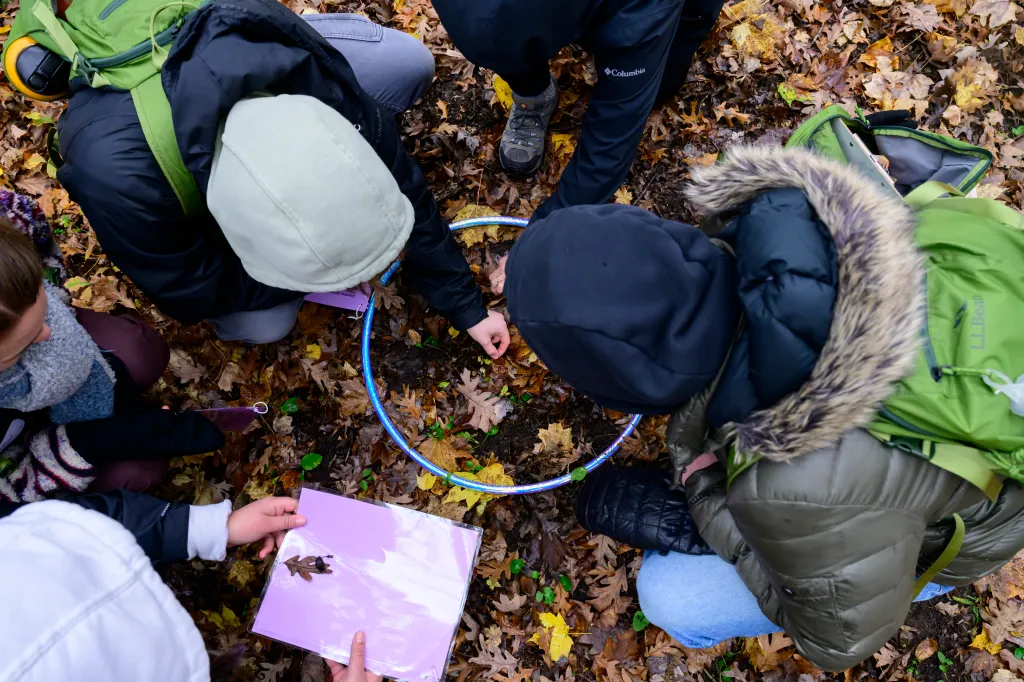Copyright St. Paul Pioneer Press

Jon Van Wyk spent last weekend in the middle of a forest in northern Washington County — learning to make contour maps, observing items found on the forest floor and coming up with nature-based math lessons that he could take back to his students at Battle Creek Elementary School in St. Paul. One idea: Use sticks of different lengths to teach subtraction. “They would have to answer questions like, ‘How much longer or how much shorter is your stick compared to your partner’s?’” Van Wyk said. “We talk about it over and over and over again in second grade: When you’re trying to find the difference, you’re doing a subtraction problem. … ‘So if his stick was 8 inches and your stick was 5 inches, you have to do the 8 minus 5 ….’ It’s practicing measuring and those math skills outside. It’s not just sitting in the classroom.” Van Wyk is one member of a cohort of 30 St. Paul Public Schools teachers selected this year to take part in Hamline University’s Teacher Field School, an immersive nature-based professional development program for K-12 teachers and specialists. The program is designed to build content knowledge, confidence and skills to use nature for teaching existing curriculum. The Teacher Field School cohort, which meets over the course of five weekends during the school year, uses land owned by the Manitou Fund in May Township. That land, about 1,400 acres, was formerly known as the Lee and Rose Warner Nature Center and Wilder Forest. Using the natural world as a learning environment to engage students is now more important than ever, Van Wyk said. “The world has changed so much, and kids are so focused on the screen that’s two feet in front of them,” he said. “Just being outside and scanning around through trees and looking at things and looking for things and being attentive to what’s going on, it takes some getting used to. You know, it’s uncomfortable at first, but the more you do it, the more it actually kind of calms them and helps them focus.” Research shows that using nature as a context for teaching can help boost academic achievement while reducing anxiety and stress in students and teachers alike, said Patty Born, the program director for Hamline University’s natural-sciences and environmental education and co-director of the Teacher Field School program. The teachers who gathered at the Manitou Fund land last weekend focused on math lessons, Born said. The September session focused on social studies. One of the math exercises involved teams of teachers placing small hula hoops on the ground to “look at all the different plant species within that area and try to determine basic density of a population,” Born said. “Or they might set a timer and count how many leaves fall into a certain area over time.” The teachers have committed to coming out to the Manitou site throughout the school year, including in the winter months, Born said. “We want them to know what it’s like to be outdoors in February,” she said. “We want them to be comfortable in any weather because the more comfortable they are, the more likely they’re going to be to take their students out.” Nature-based education Nature-based education, which started in Scandinavia, has been “slow to come to the Midwest because of people’s fears about discomfort and bugs and whatever,” said Carrie Jennings, research and policy director for the Freshwater Society and co-director of the Teacher Field School. “But you can be outside in all weather, and it levels the playing field for students with learning disabilities,” Jennings said. “They sometimes feel more empowered outdoors. There’s all these memory cues: smell, sound, and there’s just this sense of discovery that’s often lost in the classroom or is kind of tamped down.” One of Jennings’ core memories of being out at the Manitou site was on a foggy winter day in February, she said. “Patty and I were hiking around trying to decide what we were going to do next, and there was water on top of the ice on the lake, and we didn’t quite trust it, but it was sound, and it was just this eerie, strange late winter day,” she said. “It’s so memorable because of that slight fear, that slight discomfort that, you know, we try to encourage risk-taking where it’s appropriate. It’s all important developmentally. Kids are just shuttled from place to place and sheltered and on screens, and they need that. They need those experiences more than ever.” Nature-based education is particularly beneficial for students who have special needs, said Suzanne Gikas, the director of special education at Hamline University, who helps teach the Teacher Field School curriculum. “Being outdoors is therapeutic,” Gikas said. “There’s less stimulus. There’s no artificial lights. There’s no flickering. The smells are different. One of the things that I found in my teaching is that when you say, ‘We’re going outside. We’re going to do this outside,’ the students are so highly motivated.” Other benefits: Walking through different terrain is good for balance and motion and supports coordination and core strength. “They’re practicing balance just through ordinary walking activities that they don’t get inside a building,” Gikas said. “There’s just so many benefits of nature.” Teacher Field School The Freshwater Society, whose mission is “to inspire and empower people to value and preserve water,” supports the Teacher Field School because the organization believes Minnesota’s future depends on residents who value the state’s natural resources, Jennings said. “Everyone grows up to have some appreciation of nature if they’ve spent some time outdoors,” Jennings said. “They are concerned about kids being indoors and you know, who’s going to be the next steward of the land and the water? They have a 30-year perspective, is what I say. Like, these (students) will be voters someday.” Teaching teachers has a multiplier effect, Jennings said. To date, about 115 teachers representing 16 different schools from around the state have cumulatively engaged about 3,200 students a year, she said. This year’s cohort includes teachers from six SPPS elementary schools: Hamline, J.J. Hill/Obama, Jie Ming Mandarin Immersion Academy, American Indian Magnet, Battle Creek and Bruce Vento. Previous cohorts have included teachers from the Robbinsdale, Duluth and Rosemount-Apple Valley-Eagan school districts, Born said. The Teacher Field School, which is funded in part by a Legislative-Citizen Commission on Minnesota Resources grant, is for teachers only; students will not be bussed to the 1,400-acre site, Born said. “We’ve really been mindful of working with Manitou and keeping the impact on the land really light, and so that means no busing of field trips, no 500 kids at a time,” she said. “There’s so much about this particular piece of land that’s really important ecologically. It’s been really important to preserve that.” The Manitou Fund bought 329 acres in the northernmost part of Wilder Forest, along the northeastern shore of Terrapin Lake, from the Wilder Foundation in 2014 and added it to the nearby Lee and Rose Warner Nature Center. Five years later, Manitou Fund officials decided to shutter the entire 825-acre Lee and Rose Warner Nature Center, which had been operated by the Science Museum of Minnesota. Two years ago, the Manitou Fund bought the rest of the 600-acre Wilder Forest property from the Wilder Foundation, essentially saving River Grove School, a K-5 outdoor-education-focused charter school, from moving. The fund is a major benefactor of the school. Big River Farms, a land-based education program for immigrant and refugee organic farmers and farmers of color, run by the Food Group, also leases land at the site. Manitou Fund The Manitou Fund was created by Minnesota business magnate Donald McNeely, who died in 2009 at age 94. McNeely, a Minnesota Vikings co-owner who was instrumental in bringing the Washington Senators to Minnesota as the Minnesota Twins, also created the Lee and Rose Warner Nature Center in 1964 to honor his aunt and uncle and promote environmental education. McNeely, who lived on Manitou Island in White Bear Lake, created the Manitou Fund to finance many of his family’s charitable interests. In 2009, the Lee and Rose Warner Foundation, another foundation started by McNeely, was merged into the Manitou Fund. The Manitou Fund is committed to having the land, which features a bog, lakes, wetlands, upland forests, hardwood forests, grasslands and prairie, be used to promote environmental education and stewardship and connect people with nature, said Greg McNeely, Don McNeely’s eldest son. “We want people on the land who are doing scientific research like bird banding and studying the bog and the lakes,” he said. “The lakes are pristine. I think there are only 10 in the country of that quality near a major metropolitan area. … We’re committed to protecting the land, not selling it, not giving it to anybody. We’re going to continue our commitment to nature-based education.” Manitou Fund officials let researchers and bird-banders from the University of Minnesota and Augsburg University use a 180-acre parcel of land on the west side of Norell Avenue for research programs with students, said Oliver Din, a representative of the fund. One of the projects, conducted by the University of Minnesota’s Emily Schilling, involves a review of the “reproductive habitat preferences and conservation challenges” of a rare darner dragonfly, he said. May Township Chairman John Pazlar said he appreciates the Manitou Fund’s low-impact use of the land. “They’ve been an important part of our community for many years and operate under strong leadership, so I look forward to seeing what the future holds in terms of their ongoing plans for the property,” he said. The Teacher Field School, which was created in 2020 by Din, Born and Jennings, has been using the Manitou Fund land free of charge for its weekend retreats since 2021. The fund underwrote the $200,000 in seed funding for the initial program, Din said. “We know what a gift this land is, and we want to share it,” Din said. “Our hope is by having teachers come and learn from the land, they can share that knowledge with their students and their communities. At the same time, we have to be mindful of minimizing the impact on this important resource.” Lesson plans and education credits Teachers who participate have the option of receiving continuing-education units (required for professional development and license renewal), or graduate credits at Hamline, Born said. The cohort meets for a full day on Saturday and for a half-day on Sunday. The Sunday session is geared toward specific lesson plans that the teachers can immediately implement, she said. “We’ve found it’s really helpful to be very, very specific because we want to make sure teachers feel like they can walk away every weekend with something very tangible they can use in a specific subject area — because they’re giving up a lot of time to be here,” she said. Teachers are asked to think ahead of time about a lesson they already teach or a unit they know they will be delivering in the future that could be “tweaked to be more aligned with nature-based education practices,” Born said. Said Jennings: “We make sure that they’re working in grade bands and working on exercises that they can deliver that week just so they have something in their back pocket,” she said. But Born and Jennings said they also want to make sure that the teachers have time to experience “moments of wonder” while at Manitou. Cranes, bald eagles and trumpeter swans have been spotted, Jennings said. “This is such a wonderful spot because no matter how many times a person comes down here, it’s different every time, and it’s always just awe-inspiring,” Born said. Hamline to Hamline collaboration Alex Troy, the coordinator for the Hamline to Hamline Collaboration Program, a joint effort between Hamline Elementary and Hamline University, participated in a mindfulness walk in the forest last weekend as trumpeter swans honked overhead. After the walk, she pointed out a stick fort that she and a colleague had helped build in September. “It’s behind those trees right there,” she said. “We worked with teachers from a different school, and the way we were able to just start working together immediately was really cool. To have created something that is still standing is really neat, too.” Troy, 27, said her goal in joining this year’s cohort was to “help more classes feel more comfortable doing more stuff outside and ideally in partnership with some professors at (Hamline) University, which we’ve already started doing a little bit.” Two weeks ago, for example, Troy accompanied two pre-K classes to the garden at the university and “just let them pick and play in the dirt and look at ground cherries and help move dirt to cover seeds,” she said. “We wanted to just introduce them to the concept that somewhere in our community people are growing food for our community, which is really cool.” Many students at Hamline Elementary “live in apartment buildings and don’t have yards or access to that much nature outside of school,” Troy said. “We’re in a pretty urban area.” Bringing nature-based education practices to Hamline is a no-brainer “because we know that kids just really like being outside,” she said. “If we can kind of build on that thing that they already like doing and weave some learning in there, that is awesome.”



